Solar eclipse of May 21, 2031
An annular solar eclipse will occur on May 21, 2031. A solar eclipse occurs when the Moon passes between Earth and the Sun, thereby totally or partly obscuring the image of the Sun for a viewer on Earth. An annular solar eclipse occurs when the Moon's apparent diameter is smaller than the Sun's, blocking most of the Sun's light and causing the Sun to look like an annulus (ring). An annular eclipse appears as a partial eclipse over a region of the Earth thousands of kilometres wide. Occurring only 3.8 days before apogee (Apogee on May 25, 2031), the Moon's apparent diameter will be smaller.
| Solar eclipse of May 21, 2031 | |
|---|---|
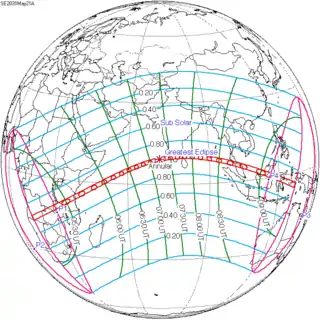 Map | |
| Type of eclipse | |
| Nature | Annular |
| Gamma | -0.197 |
| Magnitude | 0.9589 |
| Maximum eclipse | |
| Duration | 326 sec (5 m 26 s) |
| Coordinates | 8.9°N 71.7°E |
| Max. width of band | 152 km (94 mi) |
| Times (UTC) | |
| Greatest eclipse | 7:16:04 |
| References | |
| Saros | 138 (32 of 70) |
| Catalog # (SE5000) | 9577 |
Images

Animated path
Related eclipses
Solar eclipses 2029–2032
This eclipse is a member of a semester series. An eclipse in a semester series of solar eclipses repeats approximately every 177 days and 4 hours (a semester) at alternating nodes of the Moon's orbit.[1]
Note: Partial solar eclipses on January 14, 2029 and July 11, 2029 occur on the previous lunar year eclipse set.
| Solar eclipse series sets from 2029–2032 | ||||
|---|---|---|---|---|
| Descending node | Ascending node | |||
| 118 | June 12, 2029 Partial |
123 | December 5, 2029 Partial | |
| 128 | June 1, 2030 Annular |
133 | November 25, 2030 Total | |
| 138 | May 21, 2031 Annular |
143 | November 14, 2031 Hybrid | |
| 148 | May 9, 2032 Annular |
153 | November 3, 2032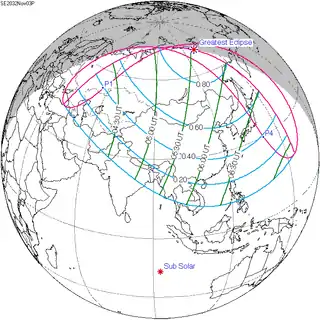 Partial | |
Saros 138
It is a part of Saros cycle 138, repeating every 18 years, 11 days, containing 70 events. The series started with partial solar eclipse on June 6, 1472. It contains annular eclipses from August 31, 1598 through February 18, 2482 with a hybrid eclipse on March 1, 2500. It has total eclipses from March 12, 2518 through April 3, 2554. The series ends at member 70 as a partial eclipse on July 11, 2716. The longest duration of totality will be only 56 seconds on April 3, 2554.
| Series members 25–35 occur between 1901 and 2100: | ||
|---|---|---|
| 25 | 26 | 27 |
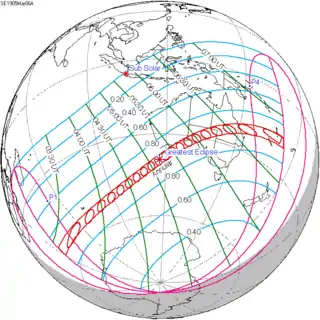 March 6, 1905 |
 March 17, 1923 |
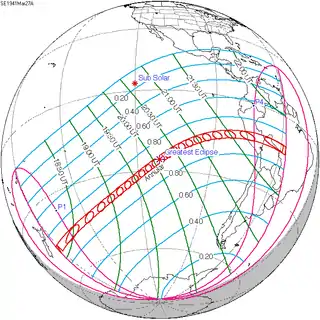 March 27, 1941 |
| 28 | 29 | 30 |
 April 8, 1959 |
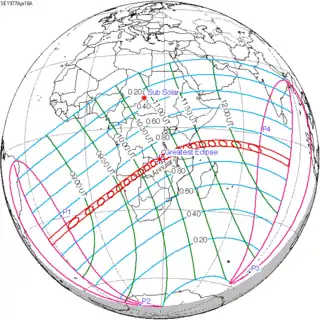 April 18, 1977 |
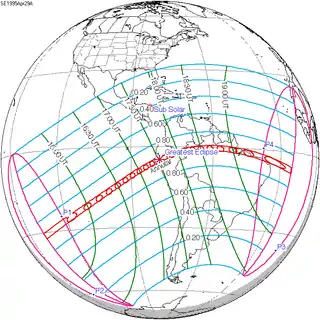 April 29, 1995 |
| 31 | 32 | 33 |
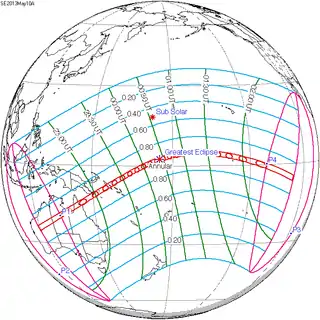 May 10, 2013 |
 May 21, 2031 |
 May 31, 2049 |
| 34 | 35 | |
 June 11, 2067 |
 June 22, 2085 | |
Metonic series
The metonic series repeats eclipses every 19 years (6939.69 days), lasting about 5 cycles. Eclipses occur in nearly the same calendar date. In addition, the octon subseries repeats 1/5 of that or every 3.8 years (1387.94 days). All eclipses in this table occur at the Moon's descending node.[2]
| Octon series with 21 events between May 21, 1993 and August 2, 2065 | ||||
|---|---|---|---|---|
| May 20–21 | March 8–9 | December 25–26 | October 13–14 | August 1–2 |
| 98 | 100 | 102 | 104 | 106 |
| May 21, 1955 | March 9, 1959 | December 26, 1962 | October 14, 1966 | August 2, 1970 |
| 108 | 110 | 112 | 114 | 116 |
| May 21, 1974 | March 9, 1978 | December 26, 1981 | October 14, 1985 | August 1, 1989 |
| 118 | 120 | 122 | 124 | 126 |
 May 21, 1993 |
 March 9, 1997 |
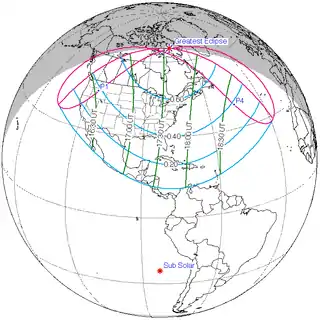 December 25, 2000 |
 October 14, 2004 |
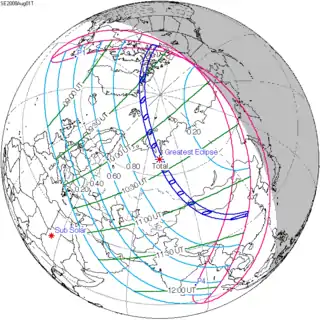 August 1, 2008 |
| 128 | 130 | 132 | 134 | 136 |
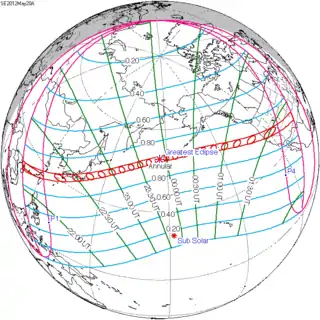 May 20, 2012 |
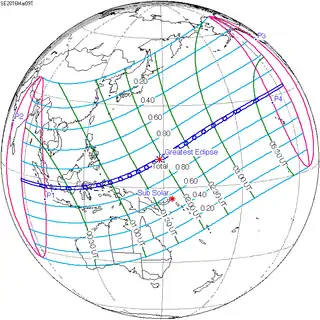 March 9, 2016 |
 December 26, 2019 |
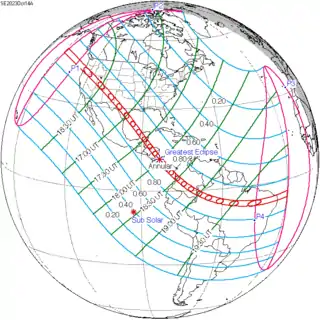 October 14, 2023 |
 August 2, 2027 |
| 138 | 140 | 142 | 144 | 146 |
 May 21, 2031 |
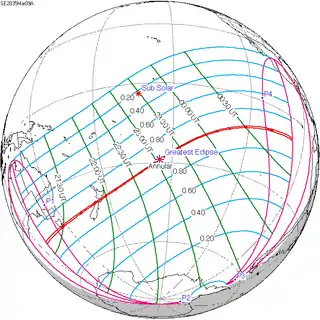 March 9, 2035 |
 December 26, 2038 |
 October 14, 2042 |
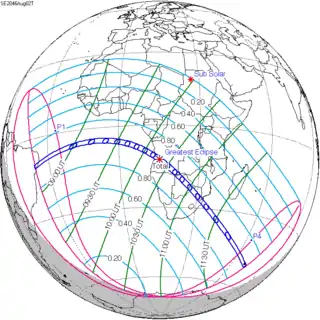 August 2, 2046 |
| 148 | 150 | 152 | 154 | 156 |
 May 20, 2050 |
 March 9, 2054 |
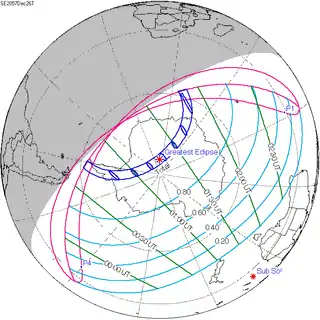 December 26, 2057 |
 October 13, 2061 |
 August 2, 2065 |
| 158 | 160 | 162 | 164 | 166 |
 May 20, 2069 |
March 8, 2073 | December 26, 2076 | October 13, 2080 | August 1, 2084 |
References
- van Gent, R.H. "Solar- and Lunar-Eclipse Predictions from Antiquity to the Present". A Catalogue of Eclipse Cycles. Utrecht University. Retrieved 6 October 2018.
- Freeth, Tony. "Note S1: Eclipses & Predictions". plos.org. Retrieved 6 October 2018.
| Wikimedia Commons has media related to Solar eclipse of 2031 May 21. |
.jpg.webp)

